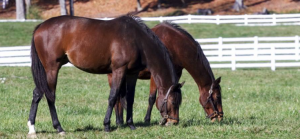 Monitor Autumn Grazing to Prevent Laminitis in Horses: Horses are at increased risk for laminitis when grass begins to grow in the spring, providing abundant forage that is high in moisture and carbohydrates but low in fiber. Autumn is also a high-risk time for grazing horses for a somewhat different reason.
Monitor Autumn Grazing to Prevent Laminitis in Horses: Horses are at increased risk for laminitis when grass begins to grow in the spring, providing abundant forage that is high in moisture and carbohydrates but low in fiber. Autumn is also a high-risk time for grazing horses for a somewhat different reason.
Pasture growth doesn’t look menacing to metabolic-challenged horses, with its browning color signaling the beginning of dormancy. However, this seasonal change triggers plants to produce and store carbohydrates. Waning daylight hours, cool night temperatures, overgrazing, mowing, or several dry days followed by rainfall. These examples can all lead to increased carbohydrate intake as horses graze. This overabundance of nonstructural carbohydrate (NSC) disrupts the chemistry of the horse’s digestive tract. Consequently leading to the release of endotoxins that can result in the onset of laminitis.
A second contributing factor is the rise in adrenocorticotropic hormone, or ACTH. This occurs in all horses as days get shorter and air temperatures drop. This natural change in hormone level may not be a problem for horses with normal metabolism. However, for those with a condition like Cushing’s disease or equine metabolic syndrome, higher ACTH levels can trigger increased insulin production. This rise translates into more risk for laminitis in susceptible equines.
Steps for Maintaining Health Throughout Fall Months
Kathleen Crandell, Ph.D., senior equine nutritionist at Kentucky Equine Research, suggests several steps to keep horses healthy throughout the fall months.
She recommends that horse owners should eliminate or limit fall grazing for insulin-resistant horses or those that have shown signs of laminitis in previous years. Offer low-NSC hay to provide fiber, soaking the hay if necessary to remove some of the water-soluble sugars. Has the grass reached full dormancy and the lower stems are no longer green? It’s probably safe to allow horses back into the pasture. At least until forage growth picks up in the spring.
Additionally, use a buffer such as EquiShure. It primes the hindgut for changes in diet that could lower the pH of the cecum and colon. By stabilizing the pH of the hindgut, there is a decrease in the risk of hindgut acidosis and associated disorders such as colic and laminitis.
J & J Hay can help to answer horse-health and hay related questions.
Source: Kentucky Equine Research
